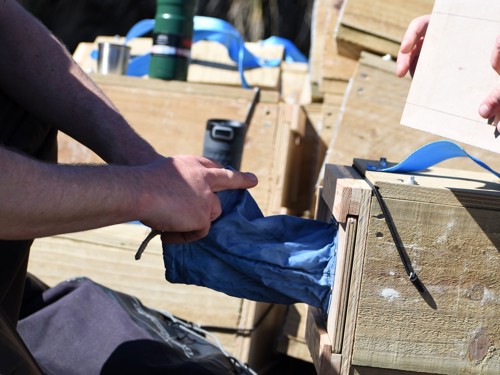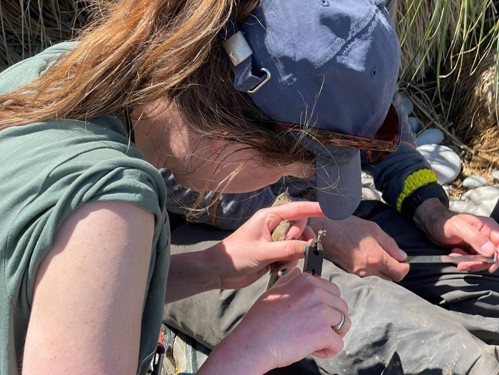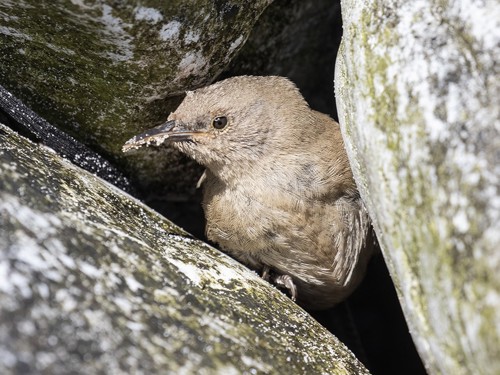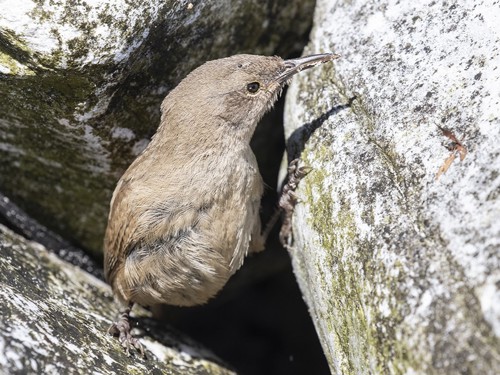Bird translocation across the ocean

Cobb's wren on stone on Kidney Island. Credit – Will Miles.
First assisted translocation of the endemic Cobb’s Wren to an island cleared of rats in the Falkland Islands
Cobb’s wren (Troglodytes cobbi) is one of just three bird species endemic to the Falkland Islands.
This small wren has adapted to forage along coastal shorelines where it scampers and hops, almost mouse-like, between boulders and cobbles, only taking flight when absolutely necessary. Its diet is highly dependent on the marine invertebrates found in the inter-tidal zone and within the stranded kelp along the high-tide line. In fact, isotope analysis has shown that 77% of the Cobb’s wren’s diet is marine-derived, making it possibly unique amongst wren species. Its numbers are greatest where cobble and boulder beaches are backed by thick tussac grass, and in this prime habitat males will fiercely defend breeding territories over the summer months.
However, Cobb’s wrens cannot survive in the presence of invasive rats and mice that have followed humans around the globe to the Falkland Islands, and much of their favoured coastal tussac grass has been removed by grazing animals since the first settlers arrived. Where Cobb’s wrens would have once foraged in a continuous distribution around the entire Falklands’ coastline, their current day distribution is much reduced, highly fragmented, and limited to only rodent-free offshore islands.

These historic losses to invasive rodents are now being reversed with suitable new habitat being created through rat eradications. In the Falklands over the last 25 years, 65 islands covering 6,500 ha have been cleared of rats. Some of this work was funded by the UK Overseas Territories Environmental Programme (OTEP), an environmental forerunner to the Darwin Plus fund.
However, many of these newly cleared islands have yet to be recolonised by the Cobb’s wren due to the large distances separating remnant populations, distances that are often far outside the natural dispersal range of this small and reticent flier. The full potential benefits from rat eradications are not being achieved without the successful recolonisation by the Cobb’s wren back into its former habitat where it once thrived. An assisted translocation programme is therefore required to help birds reach these islands.
With assisted translocation, birds are caught on one island and carefully transported to another. This movement mimics the natural dispersal of juveniles in autumn, but assisted translocation can occur over a greater distance and it ensures that birds arrive in a safe, rat-free environment with high quality coastal habitat. It also ensures that they arrive in sufficient numbers to establish breeding pairs that will give a sustainable population.

Part of the current work supported by Darwin Plus is a trial proof of concept to establish the best way to capture and move birds in a way that minimises stress and maximises the chance of success. In January 2025, seven Cobb’s wrens were captured on Kidney Island, then ringed, moved, and released on Top Island. Birds were transported in specially built transfer boxes with bedding, food, and water available at all times. These boxes were converted from the original rat trap boxes that had once previously been used for rodent clearance, a sustainable solution and a full circle moment.
All seven captured birds were successfully released on Top Island without any adverse effects. Further surveying will monitor their persistence through winter and into the first breeding season.
Once the long-term success of this translocation is proven, it is hoped that further re-introductions can be undertaken to some of the larger island groups that have been cleared of rats, such as the Arch Islands Group that were successfully cleared of rats in 2008 by Island Land Care. In such cases, birds re-introduced to one island will be able to recolonise the remaining islands in the group naturally as breeding occurs and numbers grow. This single ‘seeding’ of a population magnifies the conservation gain for the initial effort and may even assist in establishing connectivity between remnant populations. If translocation of these birds is extended to these cleared island groups, there is potential to see upwards of 76 km of new coastline habitat for the Cobb’s wren and a 20% increase in their population and occurrence across the Falkland Islands.
Written by Grant Munro. For more information on this Darwin Plus Main project DPLUS182, led by Falklands Conservation, please click here.









 Back
Back